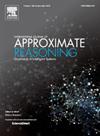A novel covering rough set model based on granular-ball computing for data with label noise
IF 3.2
3区 计算机科学
Q2 COMPUTER SCIENCE, ARTIFICIAL INTELLIGENCE
引用次数: 0
Abstract
As a novel granular computing model, granular-ball computing (GBC) has a notable advantage of robustness. Inspired by GBC, a granular-ball covering rough set (GBCRS) model whose covering is made up of granular-balls (GBs) is proposed. GBCRS is the first covering rough set that fits the data distribution well. Inheriting the robustness of GBC, GBCRS can work in label noise environments. First, the optimization objective function of GBs in GBCRS is given. In order to ensure the quality of generated GBs, this function is subject to three constraints. Second, the GBCRS model is proposed. The purity threshold is used to relax the related notions so that GBCRS can be used in label noise environments. Subsequently, GBCRS is applied to the covering granular reduction and attribute reduction in label noise environments. In covering granular reduction, we propose an intuitive, understandable and anti-noise GBCRS-based granular reduction (GBCRS-GR) algorithm, which also solves the optimization objective function of GBs. Based on GBCRS-GR, a GBCRS-based attribute reduction (GBCRS-AR) algorithm is proposed with the classification ability of the attribute subset as the evaluation. The experiments on UCI datasets illustrate that proposed algorithm is more robust against label noise than the comparison ones.
一种基于颗粒球计算的覆盖粗糙集模型
颗粒球计算(GBC)作为一种新型的颗粒计算模型,具有显著的鲁棒性。受GBC的启发,提出了一种由颗粒球组成的颗粒球覆盖粗糙集模型。GBCRS是第一个较好拟合数据分布的覆盖粗糙集。继承GBC的鲁棒性,GBCRS可以在标签噪声环境下工作。首先,给出了GBCRS中gbbs的优化目标函数。为了保证生成gb的质量,此函数受到三个约束。其次,提出了GBCRS模型。利用纯度阈值放宽相关概念,使GBCRS能够用于标签噪声环境。随后,将GBCRS应用于标签噪声环境下的覆盖颗粒约简和属性约简。在覆盖颗粒约简方面,我们提出了一种直观、易懂、抗噪声的基于gbcrs的颗粒约简(GBCRS-GR)算法,该算法也解决了gbcrs的优化目标函数。在GBCRS-GR的基础上,提出了一种基于GBCRS-AR的属性约简算法,以属性子集的分类能力作为评价标准。在UCI数据集上的实验表明,该算法对标签噪声的鲁棒性优于对比算法。
本文章由计算机程序翻译,如有差异,请以英文原文为准。
求助全文
约1分钟内获得全文
求助全文
来源期刊

International Journal of Approximate Reasoning
工程技术-计算机:人工智能
CiteScore
6.90
自引率
12.80%
发文量
170
审稿时长
67 days
期刊介绍:
The International Journal of Approximate Reasoning is intended to serve as a forum for the treatment of imprecision and uncertainty in Artificial and Computational Intelligence, covering both the foundations of uncertainty theories, and the design of intelligent systems for scientific and engineering applications. It publishes high-quality research papers describing theoretical developments or innovative applications, as well as review articles on topics of general interest.
Relevant topics include, but are not limited to, probabilistic reasoning and Bayesian networks, imprecise probabilities, random sets, belief functions (Dempster-Shafer theory), possibility theory, fuzzy sets, rough sets, decision theory, non-additive measures and integrals, qualitative reasoning about uncertainty, comparative probability orderings, game-theoretic probability, default reasoning, nonstandard logics, argumentation systems, inconsistency tolerant reasoning, elicitation techniques, philosophical foundations and psychological models of uncertain reasoning.
Domains of application for uncertain reasoning systems include risk analysis and assessment, information retrieval and database design, information fusion, machine learning, data and web mining, computer vision, image and signal processing, intelligent data analysis, statistics, multi-agent systems, etc.
 求助内容:
求助内容: 应助结果提醒方式:
应助结果提醒方式:


